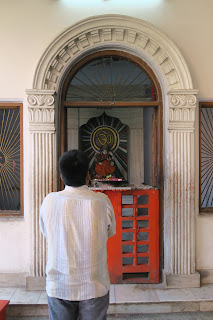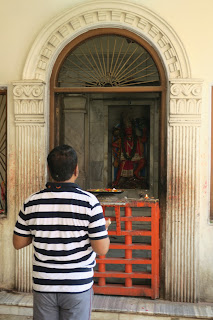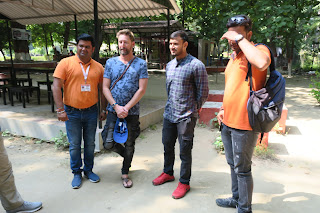Shri Vishwanath Mandir also known as Vishwanath Mandir, Vishwanath Temple, New
Vishwanath Temple and Birla Temple is one of the most famous temples and
biggest tourist attractions in the holy city of Varanasi, India.
The temple is situated in Benaras Hindu University and is dedicated to the
Lord Shiva. Shri Vishwanath Mandir has the tallest temple tower in the world
with the Vimana's height being around 250 feet.
Shri Vishwanath Mandir, although a Lord Shiva temple, consists of nine temples
within one temple and is open to people from all castes, religions and
religious beliefs.
The Shiva temple is in the ground floor and the Lakshmi Narayan and Durga
temples are on the first floor. Other temples within Shri Vishwanath Mandir
are Nataraj, Mata Parvati, Lord Ganesha, Panchmukhi Mahadev, Lord Hanuman,
Saraswati and Nandi.
Entire text of Bhagavad Gita and extracts from sacred Hindu scriptures are
inscribed with illustrations on the inner marble walls of the temple.
|
Approaching Vishwanath Temple.
In the past 900 years Shri Kashi Vishwanath Mandir was destroyed by
multiple invaders, however, the locals supported by their Hindu patrons
reconstructed this ancient temple as many times.
-
In 1930s, Pandit Madan Mohan Malaviya planned to replicate Shri Kashi
Vishwanath Mandir in the campus of Benaras Hindu University.
-
The Birla family undertook the construction and foundation was laid in
March 1931.
-
The temple (Shri Vishwanath Mandir) was finally completed in 1966.
|
|
The main entrance (East wall) of the temple.
|
|
Temple's Shikhara.
Shri Vishwanath Mandir has the tallest temple tower in the world with
the Shikhara's height being around 250 feet.
|
|
Shiva.
Shiva (lit. 'The Auspicious One'), also known as Mahadeva (lit. 'The
Great God'), is one of the principal deities of Hinduism. He is the
Supreme Being in Shaivism, one of the major traditions within Hinduism.
-
Shiva is known as 'The Destroyer' within the Trimurti, the Hindu
trinity which also includes Brahma and Vishnu.
-
In the Shaivite tradition, Shiva is the Supreme Lord who creates,
protects and transforms the universe.
-
In the goddess-oriented Shakta tradition, the Supreme Goddess (Devi)
is regarded as the energy and creative power (Shakti) and the equal
complementary partner of Shiva.
-
See more at
Shiva - Wikipedia.
|
|
Inside Vishwanath Temple.
The Shiva temple is in the ground floor and the Lakshmi Narayan and
Durga temples are on the first floor.
|
|
Shiva Temple.
In the center of the shiva temple is the lingam projected on a yoni
base.
-
A lingam (lit. "sign, symbol or mark"), sometimes referred to as linga
or Shiva linga, is an abstract or aniconic representation of the Hindu
god Shiva in Shaivism.
-
It is often represented within a disc-shaped platform, the yoni – its
feminine counterpart, consisting of a flat element, horizontal
compared to the vertical lingam, and designed to allow liquid
offerings to drain away for collection.
-
Together, they symbolize the merging of microcosmos and macrocosmos,
the divine eternal process of creation and regeneration, and the union
of the feminine and the masculine that recreates all of existence.
-
See more at
Lingam - Wikipedia.
|
|
Shiva and Ganesh.
Hindu texts identifies Ganesh as the son of Parvati and Shiva of the
Shaivism tradition, but he is a pan-Hindu god found in its various
traditions.
-
The most recurrent motif in these stories is that Ganesha was created
by Parvati using clay to protect her and Shiva beheaded him when
Ganesha came between Shiva and Parvati. Shiva then replaced Ganesha's
original head with that of an elephant.
-
See more at
Ganesha - Wikipedia.
|
|
Saraswati.
Saraswati is the Hindu goddess of knowledge, music, art, speech, wisdom,
and learning.
-
The four hands hold items with symbolic meaning – a book or script
(pustaka), a rosary or garland (mala), a water pot and a musical
instrument (vina).
-
The book she holds symbolizes the Vedas representing the universal,
divine, eternal, and true knowledge as well as all forms of learning.
-
A rosary (mala) of crystals, representing the power of meditation,
inner reflection, and spirituality.
-
A pot of water represents the purifying power to separate right from
wrong, the clean from the unclean, and essence from the inessential.
In some texts, the pot of water is symbolism for soma – the
drink that liberates and leads to knowledge.
-
The most famous feature on Saraswati is a musical instrument called a
veena, represents all creative arts and sciences, and her
holding it symbolizes expressing knowledge that creates harmony.
-
See more at
Saraswati - Wikipedia.
|
|
Mukhalinga.
Mukhalinga (literally "linga with a face") is a linga with one or more
human faces. The linga is an aniconic representation of the Hindu god
Shiva. Mukhalingas may be of stone or can be made of a metal sheath,
which covers the normal linga.
-
The mukhalinga generally has one, four or five faces. Mukhalingas
having four faces are also regarded to have an invisible fifth face at
the top of the linga. The four- and five-faced mukhalingas represent
the five aspects of Shiva, which also relate to the classical elements
and the cardinal directions.
-
The five faces relate Shiva to the classical elements, the directions,
the five senses and five parts of the body. These represent Shiva's
five aspects: Sadyojata, Vamadeva, Aghora, Tatpurusha and Ishana.
-
Alain Daniélou says that mukhalingas of Shiva resemble similar
depictions of phalluses with carved faces from Greece and those from
Celtic Europe. He also notes the phalluses with full human figures are
also found in France and India, citing the second-century Gudimallam
Lingam as an early example.
-
See more at
Mukhalinga - Wikipedia.
|
|
Hanuman.
Hanuman is a Hindu god and a divine vanara companion of the god Rama.
-
Hanuman is viewed as the ideal combination of "strength, heroic
initiative and assertive excellence" and "loving, emotional devotion
to his personal god Rama", as Shakti and Bhakti.
-
In later literature, he is sometimes portrayed as the patron god of
martial arts such as wrestling and acrobatics, as well as activities
such as meditation and diligent scholarship.
-
He symbolises the human excellences of inner self-control, faith, and
service to a cause, hidden behind the first impressions of a being who
looks like a Vanara.
-
Hanuman is considered to be a bachelor and an exemplary celibate.
-
See more at
Hanuman - Wikipedia.
|
|
Receiving a lecture on the history of Hinduism.
After we visited the temple, we were given a lecture on the history of
Hinduism. The history of Hinduism is often divided into periods of
development.
-
The first period is the pre-Vedic period, which includes the
Indus Valley Civilization and local pre-historic religions, ending at
about 1750 BCE.
-
This period was followed in northern India by the Vedic period,
which saw the introduction of the historical Vedic religion with the
Indo-Aryan migrations, starting somewhere between 1900 BCE and 1400
BCE.
-
The subsequent period, between 800 BCE and 200 BCE, is "a turning
point between the Vedic religion and Hindu religions", and a
formative period for Hinduism, Jainism and Buddhism.
-
During the Epic and Early Puranic period, from c. 200 BCE to
500 CE, the Epics and the first Purānas were composed.
-
It was followed by the
classical "Golden Age" of Hinduism (c. 320–650 CE), which
coincides with the Gupta Empire. In this period the six branches of
Hindu philosophy evolved, namely Samkhya, Yoga, Nyaya, Vaisheshika,
Mimamsa, and Vedanta. Monotheistic sects like Shaivism and Vaishnavism
developed during this same period through the Bhakti movement.
-
The period from roughly 650 to 1100 CE forms the
late Classical period or early Middle Ages, in which classical
Puranic Hinduism is established, and Adi Shankara's influential
consolidation of Advaita Vedanta.
-
Hinduism under both Hindu and Islamic rulers from c. 1200 to 1750 CE
saw the increasing prominence of the Bhakti movement, which remains
influential today.
-
The colonial period saw the emergence of various Hindu reform
movements partly inspired by western movements, such as Unitarianism
and Theosophy.
-
The Partition of India in 1947 was along religious lines, with the
Republic of India emerging with a Hindu majority.
-
See more at
History of Hinduism - Wikipedia.
|
See also
Source
Location
Ganga Aarti Ritual
Varanasi Boat Ride
Manikarnika Ghat
Gyanvapi Mosque
Bharat Mata Temple
Durga Temple in Varanasi
Shakti Religion












